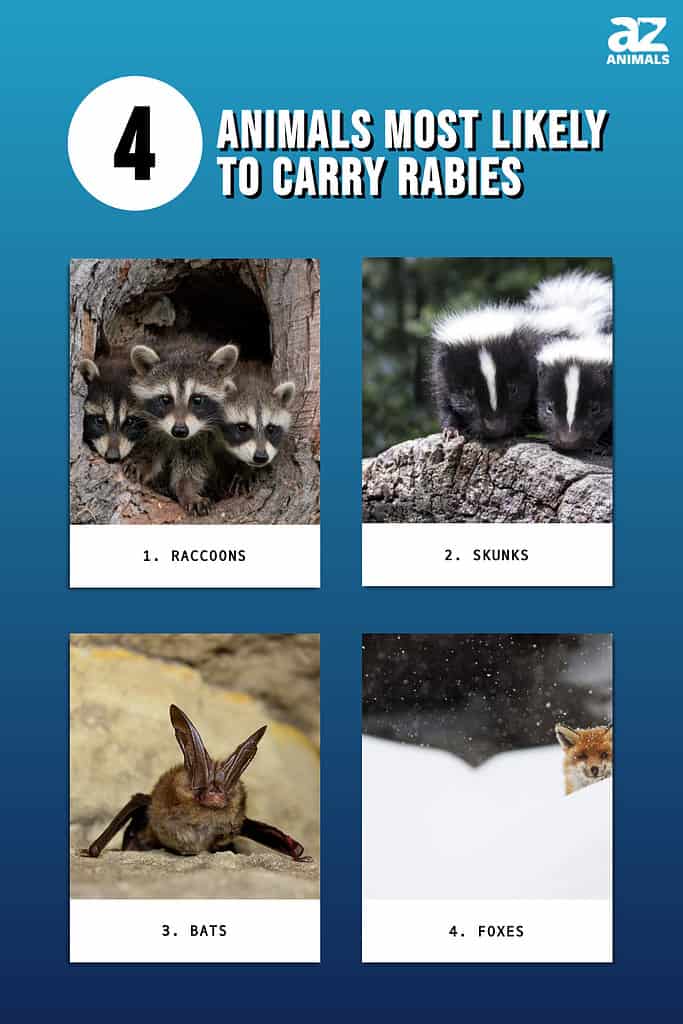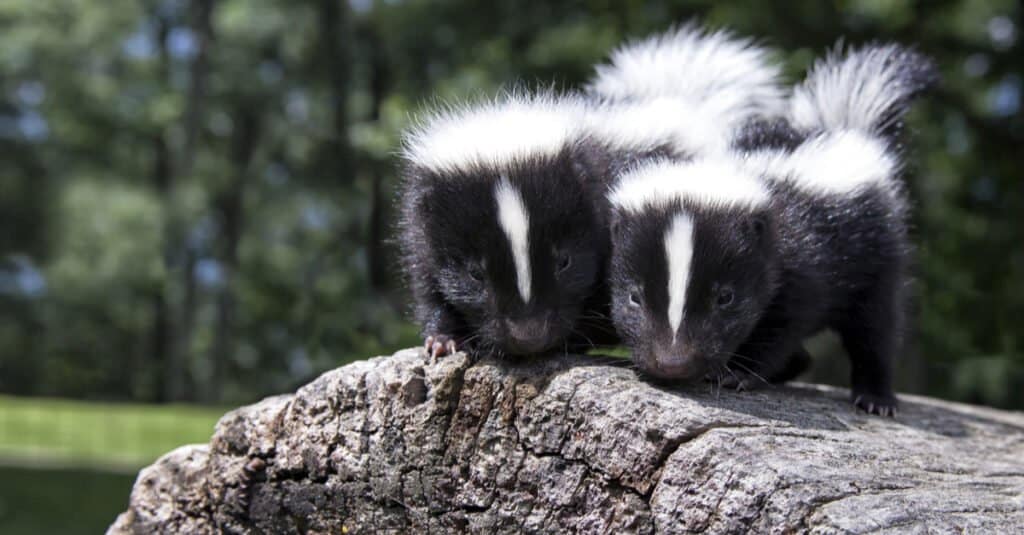Did you hear about the heroic mom who saved her kid from a rabid raccoon? The attack occurred in Connecticut where a young child was attacked after returning home from school. In the video that has since gone viral, the rabid raccoon can be seen jumping onto the front porch, grabbing the child’s leg, and biting at her feet. The girl’s mother ran outside, ripped the raccoon off her daughter, and ushered her inside. She then flung the raccoon across the yard!

Raccoons are among the four animals most likely to carry rabies in the United States, along with a few others you should be aware of.
1. Raccoons

These masked critters often take advantage of human-related resources, scouring our trashcans for food and using our sheds for shelter.
©Gerald A. DeBoer/Shutterstock.com
Raccoons make up nearly 35% of all animal-related rabies cases. The eastern United States has been dealing with rabid raccoons since the 1960s, and New York first developed a problem in the 1990s.
Living Safely With Raccoons
Raccoons often take advantage of human-related resources. They scour our trashcans for food and use our sheds and crawl spaces for shelter. Stay safe by discouraging raccoon activity near your home. Keep pet food indoors and use trash cans with secure lids. You can also keep your trash receptacles inside the garage until it’s time for pickup.
2. Skunks

Take preventive measures to keep adorable, but potentially dangerous skunks away from your yard.
©critterbiz/Shutterstock.com
Skunks are another animal likely to carry rabies in the United States. In Wisconsin, skunks are one of the most prominent carriers of the virus, alongside bats.
Living Safely With Skunks
Take preventive measures to keep skunks away from your yard. These animals enjoy foraging through garbage, pet food, and any other leftovers that might be outside. Remove any food sources, and always close your garage and shed at night. Since skunks are nocturnal, close the garage door at dusk to prevent any problems.
3. Bats

Bats aren’t naturally aggressive. However, if they feel threatened, they may bite.
©Larisa Bishop-Boros / CC BY-SA 3.0 – License
Most bats don’t carry rabies, but the few that do spread it rapidly. As a result, bats are the number one cause of human rabies-related deaths in the United States. Rabid bats exist in all 49 continental states. The only safe place is Hawaii.
Living Safely With Bats
Bats aren’t naturally aggressive. However, if they feel threatened, they may bite. If a bat flies into your house, wear extra thick gloves to remove them safely. Avoid cotton gloves, as bats can bite through them. Leather gloves are the best alternative. After carefully removing the bat from your home, seal off the entrance they used to get in.
4. Foxes

These animals don’t attack humans, except in extremely rare cases.
©Beatrice Prezzemoli/Shutterstock.com
Foxes make up around 7% of rabies cases reported to the CDC. It’s rare for the fox strain of rabies to transmit to humans. Nevertheless, immediate medical attention is required after a bite or exposure.
Living Safely With Foxes
Seeing a fox in your yard isn’t a reason to be alarmed. These animals don’t attack humans, except in extremely rare cases.
In a normal situation, a fox would run away before it would fight you. And if a fox approaches you, it may just mean it’s used to people feeding it. However, even if they don’t carry rabies, foxes who have lost their fear of people are dangerous. Avoid feeding the fox to encourage it to go away.
How Can You Tell If An Animal Has Rabies?
Raccoons, foxes, bats, and skunks appear in many US neighborhoods. How can you tell if one of these animals has rabies? Look for the key warning signs:
- Disoriented behavior
- Seizures
- Paralysis
- High-pitched vocalizations
- Self-harm
- Strange behavior
- Aggressive tendencies
- Excessive drool
Animals with rabies usually move in strange ways. They might also have a discharge from their eyes or mouth and matted hair on their face and body. If the animal is hurting itself and screaming, it’s probably sick. Another sign of rabies is oblivion. If they don’t hear noise or sound, they may have rabies or another illness that may cause them to attack.
How Common Are Human-Related Rabies Cases?
Knowledge of which animals are likely to carry rabies is essential. But that doesn’t mean you should consistently be on guard. It’s rare for humans to get rabies.
Annually, there are only one to three reports of human-related rabies cases. From 2009 to 2018, there were only 25 cases of rabies involving humans. Out of those 25 cases, seven of the infections took place outside of the United States and its territories.
Up Next:
- 10 Incredible Skunk Facts
- Watch A Raccoon With Mission Impossible Vibes Earn Their Bandit Status
- Watch A Fox U-Turn Real Fast After Seeing A Bobcat Up Close
The photo featured at the top of this post is © iStock.com/nymphoenix
Thank you for reading! Have some feedback for us? Contact the AZ Animals editorial team.






